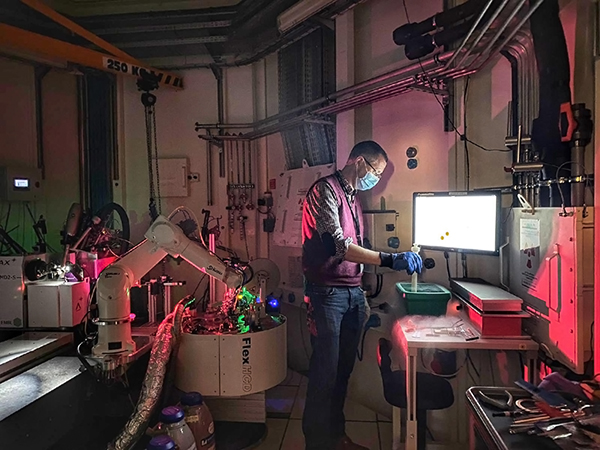- Home
- News
- General News
- Antibodies tackling...
Antibodies tackling COVID-19 variants characterised at the ESRF
15-06-2021
A new approach to identify antibodies that neutralize COVID-19 variants has been confirmed at the ESRF’s MASSIF-1 beamline. The results are published today in Frontiers of Immunology.
A year and a half since the onset of the COVID-19 pandemic, scientists have managed to develop vaccines to protect people from the virus. However, these are not widely accessible around the globe and treatments are still needed for those already infected or for immunodeficient patients who cannot be protected with vaccines.
This is where treatments can make a difference. Many companies worldwide are trying to obtain ways of curing those affected with COVID-19. Matthew Bowler (EMBL), in charge of the beamline MASSIF-1, run jointly by the ESRF and EMBL, and co-author of the study, explains: “There is a lot of drug screening going on, including here on our beamline MASSIF-1, but you are looking into a drug being approved in five to ten years. On the other hand, an antibody treatment could get approved much faster, as it is effective straight away”.
There are currently at least 25 experimental antibodies for the neutralisation of SARS-CoV-2 undergoing clinical trials. The majority of these antibodies have been identified by screening thousands of antibody-producing white blood cells from patients who have recovered from COVID-19 – specifically COVID-19 caused by the original strain first identified in Wuhan, China. However, the virus has since mutated into different variants, potentially rendering some of the clinical candidates ineffective.
A collaboration among eight different companies, charities and academic institutions in the UK and France, formed by the UK BioIndustry Association, has worked on a different, complementary approach.
The team used plasma samples from patients who either had recovered or were being treated at the time of the experiment. Their approach is based on phage display, a technology that involves combining antibody genes on a strand of DNA packaged in a safe viral protein, to make a phage antibody.
The researchers created a library of tens of millions of phage antibodies, from which they could isolate potential neutralizing molecules using SARS-CoV-2 target molecules as bait. They screened and purified the antibodies and the receptor-binding domain in the virus spike protein and crystallised both parts bound together. The team knew exactly where the variants’ changes take place on the spike protein and, thanks to the experiment on MASSIF-1, they found out the precise location where the antibodies bind, so they could see whether it was an area that changes or not depending on the variants.
Fast experiment
“It all happened very quickly”, explains Bowler. “At MASSIF-1 everything is automated and we have a very flexible schedule, so only a couple of weeks went by from the first talks until we finished screening the crystals”. There were a lot of variations in the crystals, so the team needed hundreds of samples to get good enough resolution to define the binding sites. Data acquisition took only 24 hours.
 |
|
Matthew Bowler on the beamline MASSIF-1. Credits: Mark McGee. |
The Extremely Brilliant Source played an important role in the success of the experiment. “I am absolutely convinced that EBS has allowed the beamline to collect much better data. We can scan everything with a smaller beam, which means we get better spatial resolution, and we have more flux, so that we can adapt the beam better to the size of the crystal. This means that if our crystal is small we can add more photons, and if it is bigger, we can expand it better and keep the same flux”, concludes Bowler.
This academic experiment could lead to real treatments soon: “We are currently seeking pharma partners to expedite the development of these antibodies into clinic,” says Aneesh Karatt-Vellatt, the lead author of the study, who is based at the biotech company IONTAS in Cambridge, UK. “Beyond the immediate therapeutic prospects, the rigorous and multifaceted approach used for this study provides a template for antibody discovery in future pandemics.”
Reference:
Bullen, G. et al, Frontiers in Immunology, 15 June 2021.
Text by Montserrat Capellas Espuny



